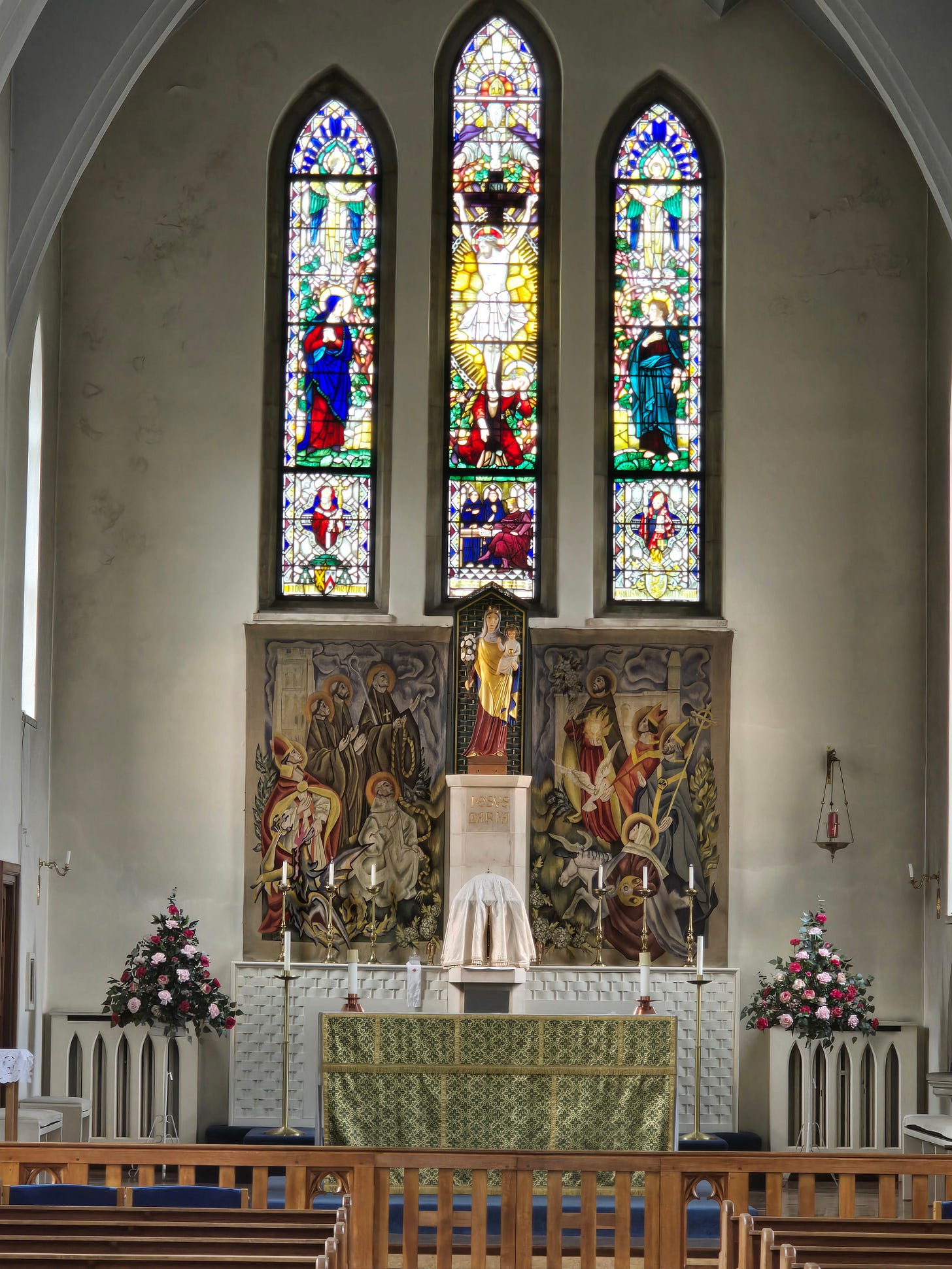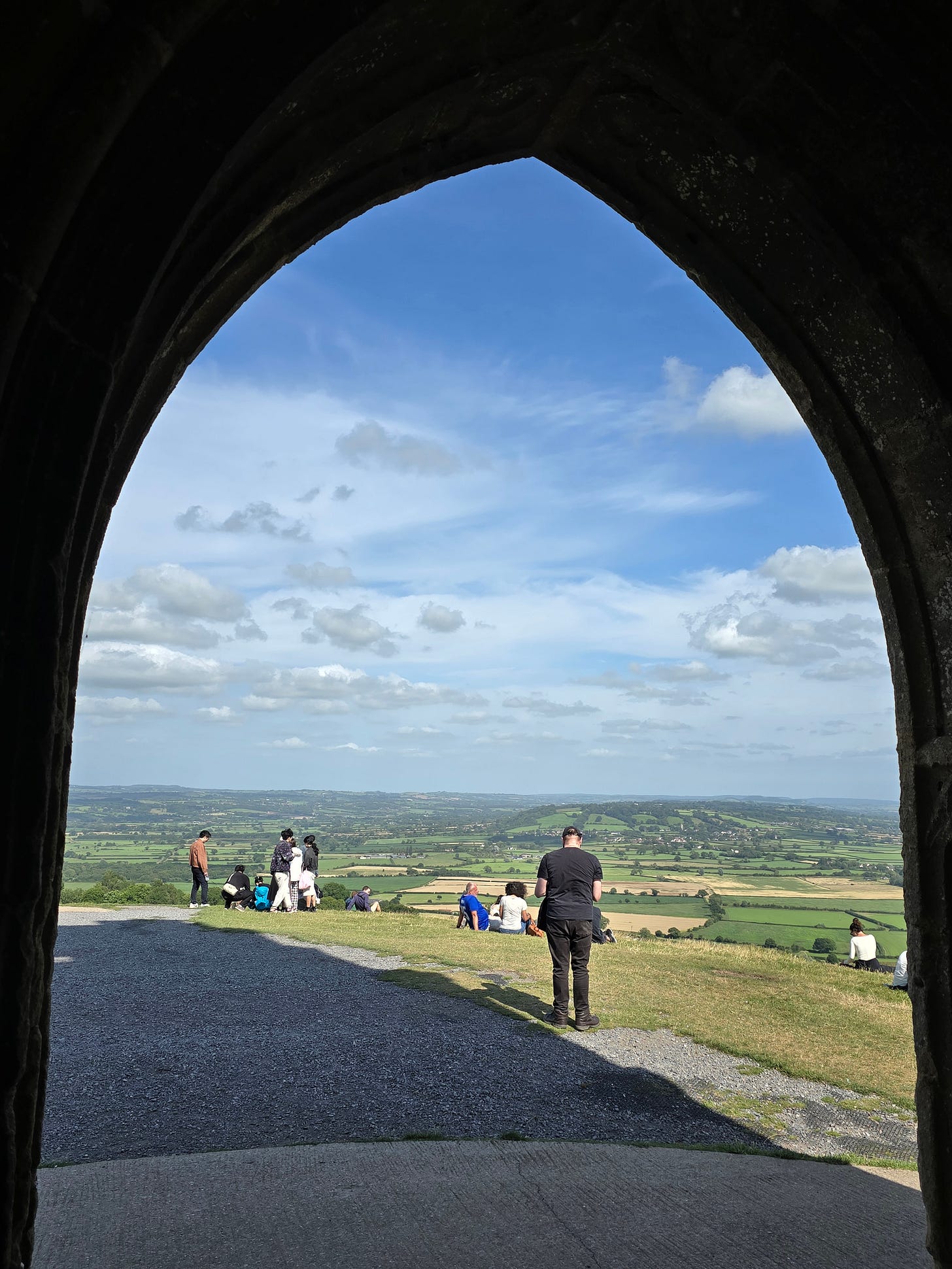Apocalypse When? Glastonbury's False Dichotomy of Pagan and Christian
Part two of my journey to sacred sites in the West of England
By the time we got to Glastonbury they were already closing the Abbey for a concert. Keane were headlining. I was hoping to show my daughter the site of the richest and largest medieval abbey in the land, legendary resting place of King Arthur and Guinevere, and site of the ‘vetusta ecclesia’ - the Lady Chapel which was said to be based on the site of a wattle and daub church, the first one outside of the Holy Land, dedicated to the Mother of our Lord.
But the concert meant the Abbey was closed by 2pm. We drove around for 30 minutes trying to park. Glastonbury was heaving, far busier than I remember it from 30 years ago. Then we realised we had arrived bang in the middle of the ‘Glastonbury Goddess Conference’, an annual event. My daughter played ‘guess the witch’ as she walked down the street, which wasn’t hard because pretty much every woman we met had pentacle earrings and heads adorned with flower crowns etc, but I said maybe we could ask them to turn us into toads and then we’d know for sure. She thought that unwise.
We tried to go and pay homage to the shrine of Our Lady of Glastonbury, which is based at the Catholic church, but it was of course locked, probably a wise thing to do in a town with so many hostile to the Faith. We did manage to get a glimpse of the beautiful statue of Our Lady through the glass door.
On my first visit to Glastonbury thirty-three years ago, I’d fully immersed myself in the town’s New Age ethos and had a profound and disturbing experience on Glastonbury Tor. The Tor is another place with a church dedicated to St Michael on it. It rises high above the town and is visible for many miles around.
Or perhaps I should say, it had a church dedicated to St Michael on it. Like St Michael of Lammana, the church was a ruin, with only the tower left. But it wasn’t time that had eroded this church, but a much more violent fate had befallen it.
In 1535 Abbot Whiting, the last Abbot of Glastonbury, had been dragged up the Tor and brutally executed. The church and abbey had slowly been destroyed over the next 300 years, the stones being used for local building. But the destruction of the monastery here, deep in the heart of Christendom, was a profound wound, as Stratford Caldecott put it so insightfully:
The destruction of the monasteries is particularly poignant as a symbol of what was taking place. It is as though our modern world was actually built on and presupposed the destruction of contemplation—or at least the destruction of that (largely Benedictine) ideal, the synthesis of contemplation and action that lay at the heart of Christendom.
The seekers here at Glastonbury come yearning to find the ‘peace that passeth understanding’, made sick by the technocratic wasteland of modernity, they seek to drink deeply from the well of the spirit.
They know that something special is to be found here. You can still feel it. Glastonbury was called ‘the holiest earth in England’ by one chronicler. And it does seem to have consistently through its history been seen as some kind of spiritual font for whatever reason.
Let’s look at some of the Christian things that were associated with Glastonbury:
The Red and White Springs, Chalice Well, the Holy Grail
Wearyall Hill, St Joseph of Arimathea, the flowering Hawthorn staff
King Arthur - the Abbey
Our Lady, St Joseph of Arimathea - the Old church at the Abbey which became the Lady chapel
Sts Patrick and David, St Bridget
But Glastonbury has also been claimed to be an ancient druidic mystery school, or centre of pre-Christian Goddess worship. One of the simplest ways to see this duality is in the symbolic richness of the Grail, legendary cup used at the Last Supper, connected to Chalice Well and Chalice Hill, which therefore links Christ with the town, but then from another perspective, the Grail as vessel of plenty, inexhaustible cauldron which feeds all, is a mythical theme in pre-Christian Celtic mythology, and thus links it to Goddess worship in the eyes of pagans.
As Jessie Weston says in Ritual To Romance:
Thus it has been perfectly possible for one group of scholars, relying upon the undeniably Christian-Legendary elements, preponderant in certain versions, to maintain the thesis that the Grail legend is ab initio a Christian, and ecclesiastical, legend, and to analyse the literature on that basis alone. Another group, with equal reason, have pointed to the strongly marked Folk-lore features preserved in the tale, to its kinship with other themes, mainly of Celtic provenance, and have argued that, while the later versions of the cycle have been worked over by ecclesiastical writers in the interests of edification, the story itself is non-Christian, and Folk-lore in origin. Both groups have a basis of truth for their arguments: the features upon which they rely are, in each case, undeniably present, yet at the same time each line of argument is faced with certain insuperable difficulties, fatal to the claims advanced.
Of course, Weston’s thesis is that the Grail legends were originally remnants of a universal pre-Christian nature ritual that initiated the seeker into “the secret sources of Life, physical and spiritual”, which however “had an esoteric mystery form which imparted higher spiritual teaching concerning the possibility of a union between man and God.” She sees this as being taken up and absorbed by Christianity.
We don’t need to do too much work to see this in the same light as Tolkien and Hugo Dyson as they walked with C S Lewis at his conversion. The mythical becomes historical in Christ. The Druidic school at Glastonbury receives the child Jesus, and realise all their teachings are pointing to Him. The cauldron of Plenty is taken up and baptised by the Grail. The Divine Mother cult points to the cult of the Mother of the Divine.
Glastonbury Goddess conference is a backward step into a fable that never really existed, and ultimately, as so many who wander in the New Age have discovered, is not truly spiritually sustaining.
But a pilgrimage to the Shrine of Our Lady of Glastonbury is to make contact with reality and to be fed with the source of Life, the true Vessel of the Precious Blood.




